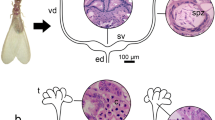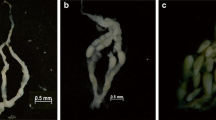Summary
Biometric studies and physiological investigations made it possible to propose a scheme of post-embryonic development and polymorphism inMacrotermes michaelseni. An instar hitherto undescribed has been found and designated fourth instar. This instar is comprised of female larvae which moult into major presoldiers. Minor presoldiers moult from some of the third instar female larvae which are morphologically identical to the female worker larvae. Three instars were detected in the case of both minor and major worker development. Workers and soldiers are sterile castes. Nymphs develop from first instar larvae and moult through five instars before imaginal moult.
Resume
Des études de biométrie et des recherches physiologiques permettent de proposer un schéma du développement post-embryonnaire et du polymorphisme chezMacrotermes michaelseni. Un stade larvaire non encore décrit a été trouvé et nommé stade IV. Ce stade correspond aux larves femelles qui muent en grands présoldats. Les petits présoldats proviennent de quelques larves femelles du stade III qui sont morphologiquement identiques aux larves d'ouvriers femelles. Trois stades larvaires sont discernés dans le cas du petit et du grand ouvrier. Tous les ouvriers et soldats sont stériles. Les nymphes passent à travers cinq stades depuis le stade I jusqu'à la mue imaginale qui donne naissance aux reproducteurs ailés.
Similar content being viewed by others
References
Bouillon A., Mathot G., 1964. Observations sur l'écologie et le nid deCubitermes exiguus (Mathot). Description de nymphes-soldats et d'un pseudimago. In: Etudes sur lesTermites Africains. Masson edit., Paris, 215–230.
Bathellier J., 1927. — Contribution à l'étude systématique et biologique des Termites de l'Indo-Chine.Faune Colonies Fran., 1, 125–365.
Fuller C., 1920. — Studies of the post-embryonic development of the antennae of Termites.Ann. Natal Mus., 4, 235–295.
Hecker H., 1966. — Das Zentralnervensystem des Kopfes und seine post-embryonale Entwicklung beiBellicositermes bellicosus (Smeath.) (Isoptera).Acta Trop., 25, 297–352.
Huxley J.S., 1932. — The coefficient of constant growth-partition; and some special cases. In: Problems of Relative Growth. J.S. Huxley ed., Lincoln Mac Veagh.The Dial Press, New York, 42–68.
Lüscher M., 1974. — Kasten und Kastendifferenzierung bei niederen Termiten. In:Sozialpolymorphismus bei Insekten. H.G. Schmidt ed., Wissenschaftl. Verlagsanst. Stuttgart., 694–739.
Lüscher M., 1976. — Evidence for an endocrine control of caste determination in higher termites. In: Phase and caste determination in insects. M. Lüscher ed.,Pergamon Press, Oxford and New York, 91–103.
Miller E.M., 1969. — Caste differentiation in the lower Termites. In: Biology of Termites. K. Krishna and F.M. Weesner ed.,Acad. Press, New York and London,1, 283–310.
N'Diaye M.S., 1977. — Le développement post-embryonnaire de l'appareil génital chez les sexués deCubitermes fungifaber (Sjostedt) (Termitidæ).Ins. Soc., 24, 37–60.vitermes (Isoptera-Nasutitermitidæ) in Nigeria, West Africa.Ins. Soc., 12, 117–130.
Noirot C., 1952. — Le polymorphisme social chez les Termites et son déterminisme. In «Structure et physiologie des sociétés animales»,C.N.R.S., édit., 103–116.
Noirot C., 1955. — Recherches sur le polymorphisme des Termites supérieurs (Termitidæ).Annals. Sci. nat. Zool., 17, 399–600.
Noirot C., 1969. — Formation of castes in higher termites. In: Biology of Termites. K. Krishna and F.M. Weesner ed.,Acad. Press, New York and London,1, 311–350.
Renoux J., 1976. — Le polymorphisme deSchedorhinotermes laminianus (Sjöstedt) (Isoptera-Rhinotermitidæ).Ins. Soc., 23, 279–491.
Romeis B., 1968. — In: Mikroskopische Technik. 16th. ed., R. Oldenbourge Verlag. München, Wien.
Sands W.A., 1965. Alate development and colony foundation in five species ofTrinervitermes (Isoptera-Nasutitermitidæ) in Nigera, West Africa.Ins. Soc., 12, 117–130.
Weesner F.M., 1953. — Biology ofTenuirostritermes tenuirostris (Desneux) with emphasis on caste development.Univ. Calif. (Berkeley) Publ. Zool., 57, 251–302.
Author information
Authors and Affiliations
Rights and permissions
About this article
Cite this article
Okot-Kotber, B.M. Instars and polymorphism of castes inMacrotermes michaelseni (Isoptera, Macrotermitinae). Ins. Soc 28, 233–246 (1981). https://doi.org/10.1007/BF02223626
Received:
Accepted:
Issue Date:
DOI: https://doi.org/10.1007/BF02223626




